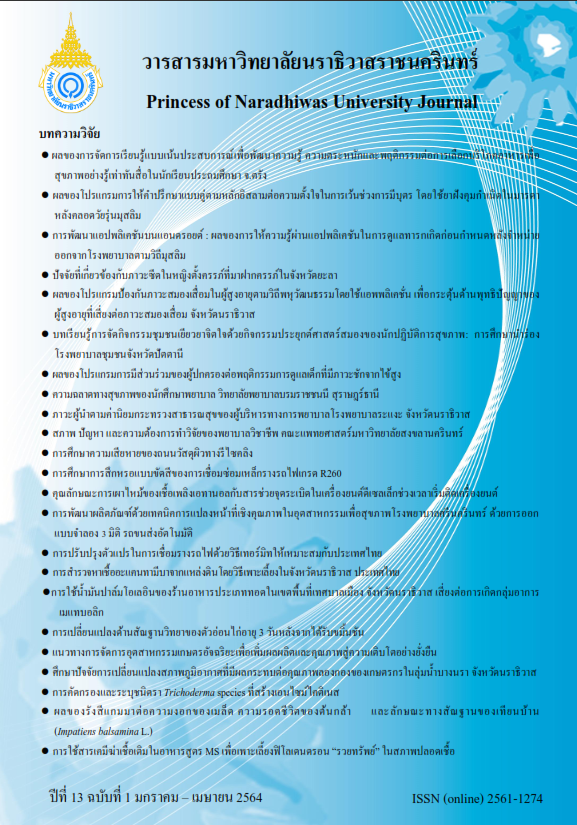Agro-Industry Management to Improve Productivity and Quality for Sustainable Growth by Smart Farming
Keywords:
Structure equation model, Industrial management guidelines, Smart FarmingAbstract
Digital transformation plays a vital role for an agro-industry to adapt themselves to increase its productivity. It leads into the idea of smart farming to uplift the agro-industry to its sustainable growth in economic and society. The objectives of this research were to study traditional agro-industry management and ways to manage smart argo-industry in order to increase the productivity and quality to reach sustainable growth. Also, the research aimed to develop structural equation model for smart argo-industry management. The research was conducted in both quantitative and qualitative. Survey and interview were conducted with 500 representatives who involved in building values in a large, a medium and a small agro-industry business sectors, living in southern, central, northern, northeastern and eastern regions of Thailand. The samples were selected using descriptive statistics and reference statistics
The results of this research revealed that the knowledge aspect such as establishing an agency for knowledge management should be focused. The innovation aspect should include encouraging innovation professionals to research new concepts in information technology, for example, encouraging to provide opportunities for information exchange of smart farming with other agencies. For the resource aspect, it should select personnel with expertise in smart agriculture to work with the organization. The process management aspect should include the analysis and in-dept examination of quality of work at every level in order to assess the capability of the department. Last, the analysis of structural equation model found that the evaluation was consistent with the empirical data (CMIN-p = .056) (CMIN/DF = 1.111) (GFI = .942) and (RMSEA = .015)
References
Andersson, & D'Souza, (2014). Agriculture, Ecosystems & Environment. 187(1), 116-132.
Bechar, A., & Vigneault, C. (2016). Agricultural robots for field operations: Concepts and components. Retrieved Apr 24, 2017. from https://www.researchgate.net/publication/305829758_ Agricultural_robots_ for_field_ operations_Concepts_and_components.
Capolupo, A., Stefania, P., Collins, O., Nunzio, F., & Lorenzo, B. (2015). Photogrammetry for environmental monitoring: the use of drones and hydrological models for detection of soil contaminated by copper, ScienDirect, University of Naples Federico II, Department of Agricultural Sciences, via University 100, 80055 Portici Naples, NA, Italy.
Iam-aram, T. (2017). The Resource-Bases view of Business Organization Evaluating value of Small and Medium Enterprises (SMEs). Journal of Thonburi University, 11, 108-123.
Judith, R. (2018). Natural Resources Allocation, Economics and Policy. Routledge Library Editions: Environmental and Natural.
Li, Z., Wang, J., Higgs, R., Zhou, L., & Yuan, W. (2017). Design of an Intelligent Management System for Agricultural Greenhouses Based on the Internet of Things. Computational Science and Engineering, CSE, IEEE International Conference.
Manwicha, J. (2015). Smart Farms Technology. Hatyai Academic Journal, 4(2), 201-210.
Moore. (2014). [online]. Capitalism as frontier: On the nature and value of "socially necessary" unpaid work. Retrieved Apr 24, 2020 from : URL : https://jasonwmoore. wordpress.com/2014/04/16/ capitalism-as-frontier-on-the-nature-and-value-of-socially-necessary-unpaid-work/.
Nessi, F., Beretta, E., Gatti, C., Ferringo, G., & Momi, S.D. (2016). Gesteme-free context-aware adaptation of robot behavior in human–robot cooperation. Artificial Intelligence in Medicine, 74, 32-43.
Nova Institute. (2015). Breakdown of WPC decking profile types in European production in 2012. Germany
Office of Agricultural Economics. (2019) Agricultural Economic Report: 3rd Yearly 2018 and Outlook for 2019. (In Thai).
Office of the National Economic and Social Development Council (2018) Annual Report 2019. Modern NESDC for Sustainable Thailand. (In Thai).
Samaimak, S., Shanin, H., Semthub, N., & Iam-borisut, P. (2017). Robot Localization by Digital Image Processing. Retrieved Apr 24, 2017. From http://reposibletory.rmtutr.ac.th //123456789/623.
Silpcharu, T. (2020). Statistical Data Analysis and Research by SPSS and AMOS, (18th ed.) Bangkok, SR Printing Mass Product.
Sundmaeker, H., Sundmaeker, C., Verdouw, S., Wolfert, L., & Freire, P. (2016). Internet of food and farm 2020. O.
Vermesan, P. Friess (Eds.), Digitising the Industry - Internet of Things Connecting Physical, Digital and Virtual Worlds, River Publishers, Gistrup/Delft, (2016), 129-151.
Wolfert, S., Ge, L., Verdouw, C., & Bogaardt, M.J. (2017). Big Data in Smart Farming A Review. Wageningen University, Netherland.




